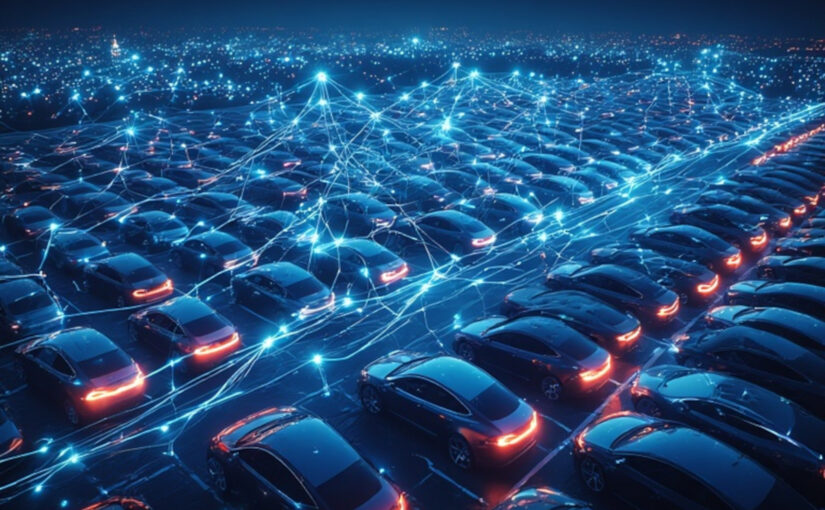In the whirlwind of Tesla’s Q3 Earnings Call, Elon Musk dropped a concept that feels straight out of science fiction. Amid discussions on revenue, robotaxis, and the usual suspects, he mused about idle Tesla vehicles moonlighting as AI powerhouses. His words capture the offhand brilliance that defines him: “Actually, one of the things I thought, if we’ve got all these cars that maybe are bored, while they’re sort of, if they are bored, we could actually have a giant distributed inference fleet and say, if they’re not actively driving, let’s just have a giant distributed inference fleet. At some point, if you’ve got tens of millions of cars in the fleet, or maybe at some point 100 million cars in the fleet, and let’s say they had at that point, I don’t know, a kilowatt of inference capability, of high-performance inference capability, that’s 100 gigawatts of inference distributed with power and cooling taken, with cooling and power conversion taken care of. That seems like a pretty significant asset.”
Musk’s quip about “bored” cars paints a vivid picture. Imagine millions of Teslas parked in garages or lots worldwide, their batteries humming quietly while their onboard AI chips crunch data instead of just waiting for the next drive. At its core, this idea revolves around creating a “distributed inference fleet.” Inference, for the uninitiated, is the process where AI models process new data to make predictions or generate outputs, like how ChatGPT responds to queries. In a traditional setup, this happens in massive data centers packed with specialized hardware. Musk envisions flipping that script. Each Tesla, equipped with hardware like the Dojo chips or the AI inference units in Full Self-Driving (FSD) computers, becomes a node in a vast, decentralized network. When the car isn’t driving, its idle compute power gets harnessed for tasks such as training AI models, rendering graphics, or even scientific simulations. The fleet’s scale could theoretically rival supercomputers, all without Tesla building new facilities. It’s a clever reuse of assets already on the road, turning everyday vehicles into a global brain.
This vision sparks intriguing technical and economic questions, starting with the nuts and bolts. On the technical side, data throughput would be a major hurdle. Vehicles scattered across cities need to send and receive data via the internet or Tesla’s cellular networks, which could bog down connections in remote areas or during peak hours. Latency issues loom large too; real-time AI tasks, like autonomous driving updates, demand split-second responses that a distributed system might not guarantee, unlike the low-latency links in centralized data centers. Energy use is another flashpoint. Musk estimates each car could deliver about one kilowatt of inference power, powered by its battery, with built-in cooling from the vehicle’s systems. Scaled to 100 million cars, that’s 100 gigawatts, enough to light up entire nations. Yet, constant draining of batteries could shorten their lifespan, forcing owners to recharge more often and potentially hike electricity bills. Privacy enters the fray here; cars would process sensitive data, raising risks of hacks or data leaks from unsecured home Wi-Fi. Economically, it’s a game-changer. Building data centers costs billions in real estate, power grids, and hardware. Tesla sidesteps that by leveraging existing fleets, potentially slashing capital expenses and monetizing downtime through services like cloud rentals. This contrasts sharply with traditional data centers, which guzzle centralized power and face supply chain bottlenecks for chips. Distributed setups, like the old SETI@Home project that crowdsourced radio signal analysis from volunteers’ PCs, show it’s feasible on a smaller scale. Folding@Home took it further, enlisting home computers for protein folding simulations during the pandemic, proving idle hardware can tackle complex problems without a central hub.
Could this fleet realistically challenge the hyperscale titans like Google, Microsoft, or Amazon? Not overnight. Those giants operate exascale data centers optimized for efficiency, with redundant cooling and fiber-optic interconnects that minimize delays. A car-based network, while innovative, faces coordination nightmares; not every owner would opt in, and variables like traffic jams or battery states could disrupt availability. Still, for niche applications like edge computing, where data stays local to reduce transmission needs, it might carve a niche. Tesla’s vertical integration, from chips to software, gives it an edge over fragmented rivals.
For Tesla, the upsides are tantalizing. Cost savings jump out first; why pour billions into new infrastructure when your product is already a mobile supercomputer? Network resilience improves too, as the system spreads risk; a storm knocking out one data center won’t cripple the whole operation. Consumer incentives could sweeten the deal, perhaps through credits on FSD subscriptions or free Supercharging for participants, much like how Uber rewards drivers for availability. Integration with Tesla’s ecosystem shines brightest. This fleet could supercharge Dojo supercomputers for AI training, refine autonomous driving algorithms in real time, or even extend to xAI’s Grok models. Imagine your parked Model Y contributing to global AI advancements while earning you perks. It’s a symbiotic loop that ties hardware sales to service revenue.
So, is this one of Musk’s visionary sparks destined to fizzle, like some past Hyperloop dreams, or a blueprint for AI’s decentralized future? The idea brims with potential, echoing how blockchain distributed trust without banks. Yet practicality tempers the hype; regulatory hurdles, like data sovereignty laws across borders, and owner buy-in remain untested. If Tesla pilots this with a small fleet, it could evolve beyond the cloud era, where compute isn’t hoarded in silos but flows from the world’s roads. For now, it’s a bold reminder that innovation often starts with a “bored” idea.
Navigate the future with confidence. Subscribe to the Techmented newsletter for biweekly insights on the AI, robotics, and healthcare innovations shaping our world. Get the expert analysis you need, delivered straight to your inbox.
